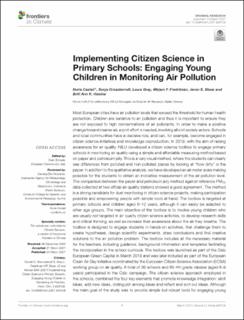| dc.description.abstract | Most European cities have air pollution levels that exceed the threshold for human health protection. Children are sensitive to air pollution and thus it is important to ensure they are not exposed to high concentrations of air pollutants. In order to make a positive change toward cleaner air, a joint effort is needed, involving all civil society actors. Schools and local communities have a decisive role, and can, for example, become engaged in citizen science initiatives and knowledge coproduction. In 2019, with the aim of raising awareness for air quality, NILU developed a citizen science toolbox to engage primary schools in monitoring air quality using a simple and affordable measuring method based on paper and petroleum jelly. This is a very visual method, where the students can clearly see differences from polluted and non-polluted places by looking at “how dirty” is the paper. In addition to the qualitative analysis, we have developed an air meter scale making possible for the students to obtain an indicative measurement of the air pollution level. The comparison between the paper and petroleum jelly method against reference PM10 data collected at two official air quality stations showed a good agreement. The method is a strong candidate for dust monitoring in citizen science projects, making participation possible and empowering people with simple tools at hand. The toolbox is targeted at primary schools and children aged 6–12 years, although it can easily be adapted to other age groups. The main objective of the toolbox is to involve young children who are usually not targeted in air quality citizen science activities, to develop research skills and critical thinking, as well as increase their awareness about the air they breathe. The toolbox is designed to engage students in hands-on activities, that challenge them to create hypotheses, design scientific experiments, draw conclusions and find creative solutions to the air pollution problem. The toolbox includes all the necessary material for the teachers, including guidance, background information and templates facilitating the incorporation in the school curricula. The toolbox was launched as part of the Oslo European Green Capital in March 2019 and was later included as part of the European Clean Air Day initiative coordinated by the European Citizen Science Association (ECSA) working group on air quality. A total of 30 schools and 60 4th grade classes (aged 8–9 years) participated in the Oslo campaign. The citizen science approach employed in the schools, combined the four key elements that promote knowledge integration: elicit ideas, add new ideas, distinguish among ideas and reflect and sort out ideas. Although the main goal of the study was to provide simple but robust tools for engaging young children in air quality monitoring, we also carried out ex-ante and ex-post evaluations in 12 of the participating classes using a 10-question multiple choice test to have an indication of the contribution of the activity to knowledge integration. The results show that there is an increase in the number of correct answers, as well as a reduction in the misconceptions after conducting the activity. These results indicate that applying a citizen science approach improved science instruction and helped knowledge integration by including students' views and taking advantage of the diverse ideas students generated. Citizen science gives learners an insight into the ways that scientists generate solutions for societal problems. But more important, citizen science provides a way to differ from the classic view of the learner as an absorber of information, by considering the social context of instruction and making the topic personally relevant. | en_US |

